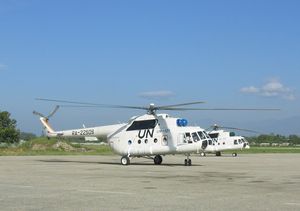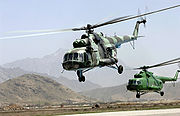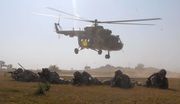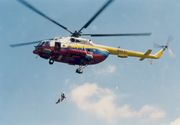Mil Mi-17
| Mi-17 / Mi-8M | |
|---|---|
 |
|
| Two Mi-17 (Mi-8MTV1) being used for the UN | |
| Role | Transport helicopter |
| Manufacturer | Mil Moscow Helicopter Plant Kazan Helicopter Plant |
| First flight | 1970s |
| Introduced | 1970s |
| Status | In service |
| Primary users | Russia ca. 60 other countries |
| Produced | about 12,000[1] |
| Developed from | Mil Mi-8 |
The Mil Mi-17 (also known as the Mi-8M series in Russian service, NATO reporting name "Hip") is a Russian-designed helicopter currently in production at two factories in Kazan and Ulan-Ude. Mil Mi-8/17 is a medium twin-turbine transport helicopter that can also act as a gunship. The Soviet Union specifically designed the Mi-17 for the Soviet war in Afghanistan.[2]
Contents |
Development
Developed from the basic Mi-8 airframe, the Mi-17 was fitted with the larger TV3-117MT engines, rotors, and transmission developed for the Mi-14, along with fuselage improvements for heavier loads. Optional engines for 'hot and high' conditions are the 1545 kW (2070 shp) Isotov TV3-117VM. Recent exports to China and Venezuela for use in high mountains have the new VK-2500 version of the engine with FADEC control.
The designation Mi-17 is for export; Russian armed forces call it Mi-8MT. The Mi-17 can be recognized because it has the tail rotor on the port side instead of the starboard side, and dust shields in front of the engine intakes. Engine cowls are shorter than on the TV2 powered Mi-8, not extending as far over the cockpit, and an opening for bleed-valve outlet is present forward of the exhaust.
Actual model numbers vary by builder, engine type, and other options. As an example, the sixteen new Ulan Ude built machines delivered to the Czech Air Force in 2005 with –VM model engines were designated as Mi-171Sh, a development of the Mi-8AMTSh. Modifications include a new large door on the right side, improved Czech-built APU, Kevlar armor plates around the cockpit area and engines. Eight have a loading ramp in place of the usual clamshell doors, and will load a vehicle up to the size of an SUV.

In October 2007 defense-aerospace.com reported the government of Saudi Arabia had signed a contract for up to 150 Mi-35 and Mi-17 helicopters worth $2.2billion.[3]
In May 2008, licensed production of the Mi-17 started in China with production being led by Mil Moscow Helicopter Plant JSC and the Sichuan Lantian Helicopter Company Limited in Chengdu, Sichuan province. The plant had built 20 helicopters in 2008, using Russian Ulan-Ude-supplied kits. The production is expected to reach 80 helicopters per year eventually. The variants to be built by Lantian will include Mi-171, Mi-17V5, and Mi-17V7.[4]
Operational history
Service usage

In the Sri Lankan Civil War, the Mi-17 saw extensive usage by the Sri Lanka Air Force. Seven of them were lost in combat and attacks on airports.[5]
The Mi-17 was used by Colombian Army in the Operation Jaque.
In 2001 the Macedonian Air Force has used the Mi-17 against Albanian insurgents.
The Mi-17 is also used for search and rescue teams like Malaysian Fire and Rescue Department in Malaysia.
Executive Outcomes used them extensively in its operations in the Angolan Civil War.
The Mexican Navy utilizes their Mi-17's for anti-narcotic operations such as locating marijuana fields and dispatching marines to eradicate the plantations.[6]
Recent orders
On 28 October 2008, the Royal Thai Army announced a deal to buy 6 Mi-17s to meet its requirement of a medium-lift helicopter, marking the first time the Thai military will acquire Russian aircraft instead of American.[7] Flight International quotes the Thai army’s rationale: "We are buying three Mi-17 helicopters for the price of one Black Hawk. The Mi-17 can also carry more than 30 troops, while the Black Hawk could carry only 13 soldiers. These were the key factors behind the decision."[8]
On 15 December 2008, Defense News reported that India will purchase 80 Mi-17IV helicopters which will be delivered to Indian Air Force between 2010 and 2014. These will replace aging Mi-8s.
On June 11, 2009, it was announced that the United States handed over four Mi-17 cargo helicopters to the Pakistan Army to facilitate its counter-terrorism operation.
On July 10, 2009. It was announced that Chile will push talks with Russia to purchase five Mi-17 multirole helicopters for the Chilean Air Force despite pressure from the United States.[9]
On September 16, 2009, US Navy's Navair delivered the last two of four Mi-17s to the Afghan National Army Air Corps.[10] On June 19, 2010, it was announced that the US government will buy and refurbish 31 Mi-17 helicopters from Russia to supply the Afghan Army.[11]
The US is reportedly considering adding the helicopter to the US military for Special Forces use in order to obscure troop movements.[12] The US uses some Mi-8s and Mi-17s for training,[13] and has purchased units for allies in Iraq, Afghanistan and Pakistan.[12]
Variants



.jpg)

.jpg)
.jpg)

- Mi-8AMT
- Slightly modified version of Kazan's Mi-8MTV, built in Ulan-Ude from 1991 and still powered by TV3-117VM engines although nowadays VK-2500 engines are optional. Also known as Mi-171.
- Mi-8AMTSh
- Armed assault version of the Mi-8AMT, can carry the same range of weapons as the Mi-24 including the "Shturm" ATGM. Fitted with a new large door on the right side (except the prototype), kevlar plates around the cockpit area and engines, and sometimes a loading ramp in place of the usual clamshell doors. Czech Republic and Croatia have ordered these types in 2005 and 2007. Bangladesh Air Force also operates Mi-171Sh as armed helicopter[14]
- Mi-8MT
- Updated version of the Mi-8T, powered by two 3,846-shp (2,868-kW) Klimov TV3-117MT turboshaft engines. The export version is known as Mi-17.
- Mi-8MTV
- Hot and High version, fitted with a pressurised cabin and powered by two Klimov TV3-117VM high-altitude turboshaft engines. This type has a maximum ceiling of 6,000 m.
- Mi-8MTV-1
- Radar-equipped civil version of the Mi-8MTV. Russian designation of the Mi-17-1V.
- Mi-8MTV-2
- Improved version of the MTV-1 with enhanced armour, updated systems, an anti-torque rotor and a accomodation for 30 troops instead of 24.
- Mi-8MTV-3
- Military version of the Mi-8MTV-2, fitted with four instead of sixweapons pylons but the number of possible external stores combinations was increased from 8 to 24.
- Mi-8MTV-5
- Military utility transport helicopter, powered by two Klimov TV3-117VM turboshaft engines and equipped with a loading ramp instead of the clamm-shel doors, an additional door and a new "dolphine nose".
- Mi-8MTV-5-Ga
- Civilian version of the Mi-8MTV-5.
- Mi-8MTKO
- Night attack conversion of the Mi-8MT and Mi-8MTV helicopters. Known in Belarus as Mi-8MTKO1.
- Mi-8MTD
- Electronic jamming version of the Mi-8MT.
- Mi-8MTF
- Smoke-screen laying version.
- Mi-8MTG
- Electronic jamming version of the Mi-8MT with "Gardenya-1FVE" single H/I-band jamming system. Export designation Mi-17PG.
- Mi-8MTI (NATO - Hip-H EW5)
- Electronic jamming version of the Mi-8MT with "Ikebana" single D-band jamming system. Also known as Mi-13, export designation Mi-17PI.
- Mi-8MTPB (NATO - Hip-H EW3)
- Electronic jamming version of the Mi-8MT with "Bizon" jamming system. Export designation Mi-17PP.
- Mi-8MTPSh
- Electronic jamming version of the Mi-8MT with "Shakhta" jamming system. Export designation Mi-17PSh.
- Mi-8MTS
- Sigint version of the Mi-8MT.
- Mi-8MTR1
- Electronic jamming version of the Mi-8MT.
- Mi-8MTR2
- Electronic jamming version of the Mi-8MT.
- Mi-8MTSh1
- Electronic jamming version of the Mi-8MT.
- Mi-8MTSh2 (NATO - Hip-H EW4)
- Electronic jamming version of the Mi-8MT.
- Mi-8MTSh3 (NATO - Hip-H EW6)
- Electronic jamming version of the Mi-8MT.
- Mi-8MTT
- Sigint version of the Mi-8MT.
- Mi-8MTYa
- Electronic jamming version of the Mi-8MT.
- Mi-8MS
- VIP version. Sub-variants are Mi-8MSO and Mi-8MSD.
- Mi-17 (NATO - Hip-H)
- Improved version of the Mi-8, powered by two Klimov TV3-117MT turboshaft engines. Basic production version.
- Mi-17-1M
- High altitude operations version, powered by two Klimov TV3-117VM turboshaft engines.
- Mi-17-1V
- Military transport, helicopter gunship version, powered by two Klimov TV3-117VM turboshaft engines. Export version of the Mi-8MTV-1.
- Mi-17-1VA
- Flying hospital version.
- Mi-17V-3
- Export version of the Mi-8MTV-3.
- Mi-17V-5
- Export version of the Mi-8MTV-5.
- Mi-17M
- Demonstration model from 1993, served as the basis for the Mi-17MD (nowadays known as Mi-17V-5).
- Mi-17MD
- Initial designator of the Mi-17V-5, developed in 1995 and from 1996 fitted with a loading ramp.
- Mi-17KF
- Export version fitted with new avionics.
- Mi-17N
- Export version of the Mi-8MTKO with GOES-321M turret with LLLTV and FLIR.
- Mi-17P
- Export version, passenger transport helicopter.
- Mi-17PG
- Export version of the Mi-8MTG.
- Mi-17PI
- Export version of the Mi-8MTI.
- Mi-17PP
- Export version of the Mi-8MTPB.
- Mi-17S
- VIP version.
- Mi-17AE
- Little-known SAR and medevac version given to Poland.
- Mi-17 LPZS
- Specialised version for the SAR units (Leteckej Pátracej a Záchrannej Služby) of Slovakia. Four ordered.[15]
- Mi-17Z-2 “Přehrada”
- Czech electronic warfare version withtwo large canisters on each side.
- Mi-18
- Prototype design, a modification of the existing Mil Mi-8. Two Mi-8s were extended by 0.9 meters (3 ft), the landing gear made retractable, and a sliding door added to the starboard side of the fuselage. The Mi-18s were used in the Soviet invasion of Afghanistan, and later used as static training airframes for pilots of the Mi-8/8MT.
- Mi-19
- Airborne command post version for tank and motorized infantry commanders (based on Mi-8MT/Mi-17 airframe).
- Mi-19R
- Airborne command post version similar to Mi-19 for commanders of rocket artillery (based on Mi-8MT/Mi-17 airframe).
- Mi-171
- Export version of the Mi-8AMT, built in Ulan-Ude.
- Mi-171C
- Chinese built variant of Mi-171 by Sichuan Lantian Helicopter Company Limited.
- Mi-171Sh
- Export version of the Mi-8AMTSh.
- Mi-172
- Civil passenger version manufactured in Kazan plant and based on the Mi-8MTV-3.
Operators
Future operators
Incidents
- In 2004 an Mi-17 carrying then Vice-President of Kenya, Moody Awori crash-landed at Athi River town in the outskirts of the Kenyan capital city, Nairobi. No one was injured.
- January 12, 2008 Mi-17 of the Macedonian Armed Forces crashed, killing all three crew members and eight passengers.
- May 31, 2008 a People's Liberation Army Mi-171 transport crashed in southwest Sichuan provinces with 14 onboard. It was operating mission during 2008 Sichuan earthquake.[18]
- May 3, 2009 a Venezuelan Air Force Mi-17 transport crashed in west Tachira province with 18 onboard.
- May 11, 2009 a Kenya police Mi-17 carrying 28 people including the Police chief and a minister crashed in Western Kenya with serious injuries to many of them.No dead were reported.
- July 4, 2009 A Pakistan Army Mi-17 carrying military personnel crashed in Orakzai Agency due to technical fault. Though there was a rumor that it was hit by Taliban but facts showed that it developed a technical fault resulting in crash.[19]
- October 25, 2009 A Mi-17 of the Pakistan Army crashed in a security forces controlled area of the Bajaur Agency's Nawagai tehsil after supplying fuel and rations to a remote military post, killing 3 personnel of the Frontier Corps, and injuring the pilot, the co-pilot and 4 others. Cause of the crash was the development of a technical fault.
Specifications (Mil-17)
General characteristics
- Crew: Three – two pilots and one engineer
- Capacity: 32 passengers or 4,000 kg (8,800 lb) on internal/4,500 kg (10,250 lb) external hardpoints.
- Length: 18.42 m (60 ft 5 in)
- Rotor diameter: 21.352 m (69 ft 10 in)
- Height: 4.76 m (15 ft 7 in)
- Disc area: 356 m² (3,830 ft²)
- Empty weight: 7,100 kg (15,700 lb)
- Loaded weight: 11,100 kg (24,470 lb)
- Max takeoff weight: 13,000 kg (28,700 lb)
- Powerplant: 2× Klimov TV3-117VM turboshafts, 1,545 kW (2225 shp) each
Performance
- Maximum speed: 250 km/h (156 mph)
- Range: 950 km (594 miles)
- Service ceiling: 6,000 m (19,690 ft)
- Rate of climb: 8 m/s (1,575 ft/min)
- Disc loading: 31 kg/m² (6 lb/ft²)
- Power/mass: 0.26 kW/kg (0.16 hp/lb)
- Fuel consumption: 600 kg/h (1,320 lb/h)
Armament
- up to 1,500 kg (3,300 lb) of disposable stores on six hardpoints, including bombs, rockets, and gunpods.
See also
Related development
- Mil Mi-8
- Mil Mi-14
- Mil Mi-38
Comparable aircraft
- Aérospatiale Super Frelon
- Eurocopter AS332
- AgustaWestland EH101
- NHI NH90
References
- ↑ RIA Novosti - Russia - Russia denies supplying arms to Iraq -1
- ↑ http://www.washingtonpost.com/wp-dyn/content/article/2010/06/18/AR2010061805630_pf.html
- ↑ "France Loses Out as Saudis Sign $2.2 Billion Deal for Russian Helos". defense-aerospace.com, Tuesday 30 October 2007
- ↑ Mi-17 Hip Multirole Helicopter. Retrieved on May 25, 2008.
- ↑ "Sri Lanka, since 1971". ACIG Journal. 2003-10-29. http://www.acig.org/artman/publish/article_336.shtml. Retrieved 2008-10-30.
- ↑ http://www.semar.gob.mx/sitio/?option=com_content&task=view&id=741&Itemid=288
- ↑ Bangkok Post Army to buy Russian choppers
- ↑ [1] Thai army chooses Russian helicopters
- ↑ http://en.rian.ru/mlitary_news/20090710/155488759.html
- ↑ http://www.navair.navy.mil/press_releases/index.cfm?fuseaction=home.view&Press_release_id=4223&site_id=29
- ↑ http://www.msnbc.msn.com/id/37793266/ns/politics-washington_post/
- ↑ 12.0 12.1 U.S. military criticized for purchase of Russian copters for Afghan air corps. Washington Post,
- ↑ 13.0 13.1 Harding, Stephen (1997). U.S. Army Aircraft Since 1947. Atglen, PA, USA: Schiffer Publishing Ltd.. pp. 184. ISBN 96-69996.
- ↑ http://www.baf.mil.bd/recruitment/aircraft.html
- ↑ http://www.ceslet.cz/en/military-programs/mi17-vir32-ff2101-dme442-nvg-i56/
- ↑ http://infodefensa.com/lamerica/noticias/noticias.asp?cod=2187&ref=Tierra&n=Garr%E9-confirma-la-adquisici%F3n-de-helic%F3pteros-M-17y-Bell-206-y-la-modernizaci%F3n-de-S%FAper-Puma-y-Huey-II
- ↑ http://desarrolloydefensa.blogspot.com/2010/03/rusia-y-chile-planean-firmar-un.html
- ↑ Helicopter with 14 aboard crashes on quake relief mission in China
- ↑ [2]
The initial version of this article was based on material from aviation.ru. It has been released under the GFDL by the copyright holder.
External links
- Mi-17 DataBase
- Mi-17 Photo Gallery
- Mi-17 section at www.aviation.ru
- Venezuelan MI-17 site
- Mi 171V Malaysia Fire Department - Bomba
|
|||||
|
||||||||||||||